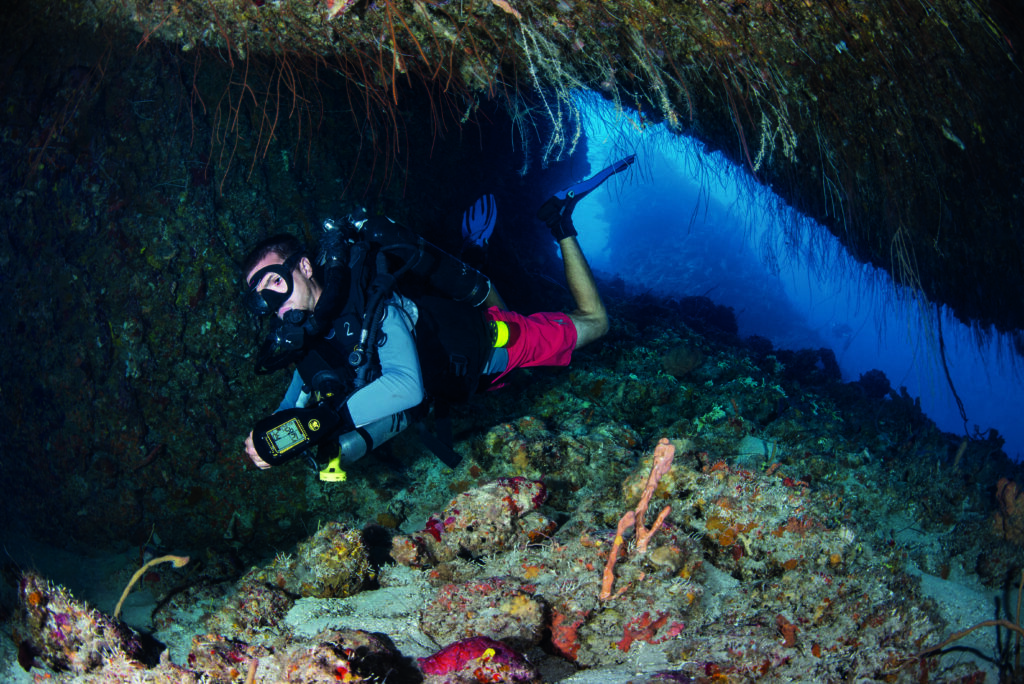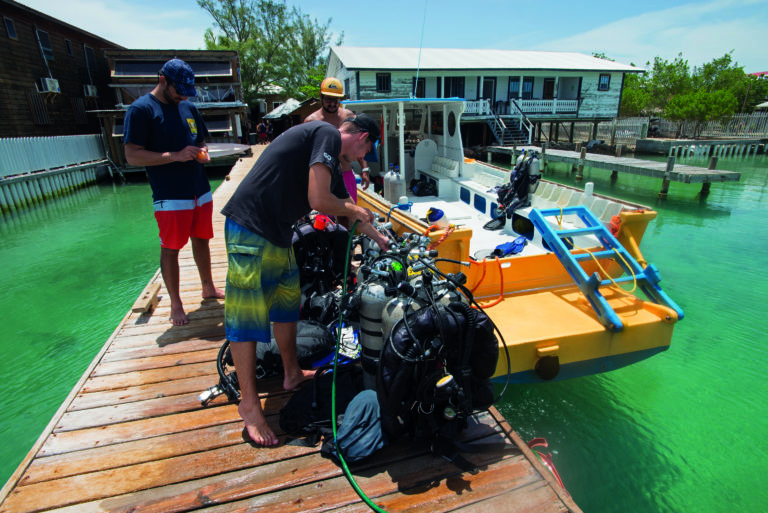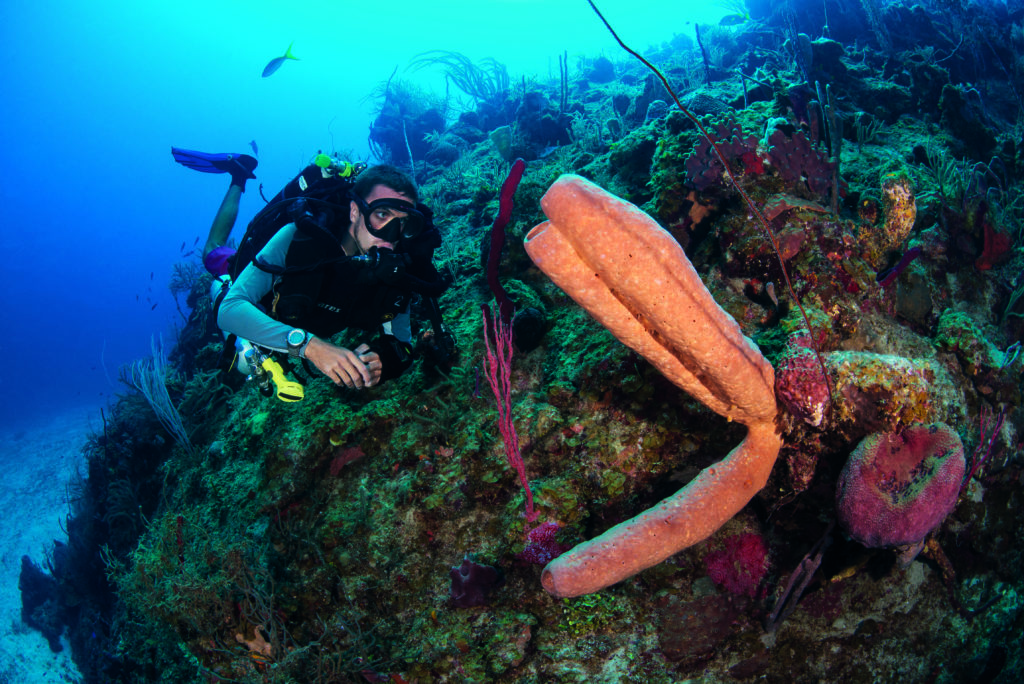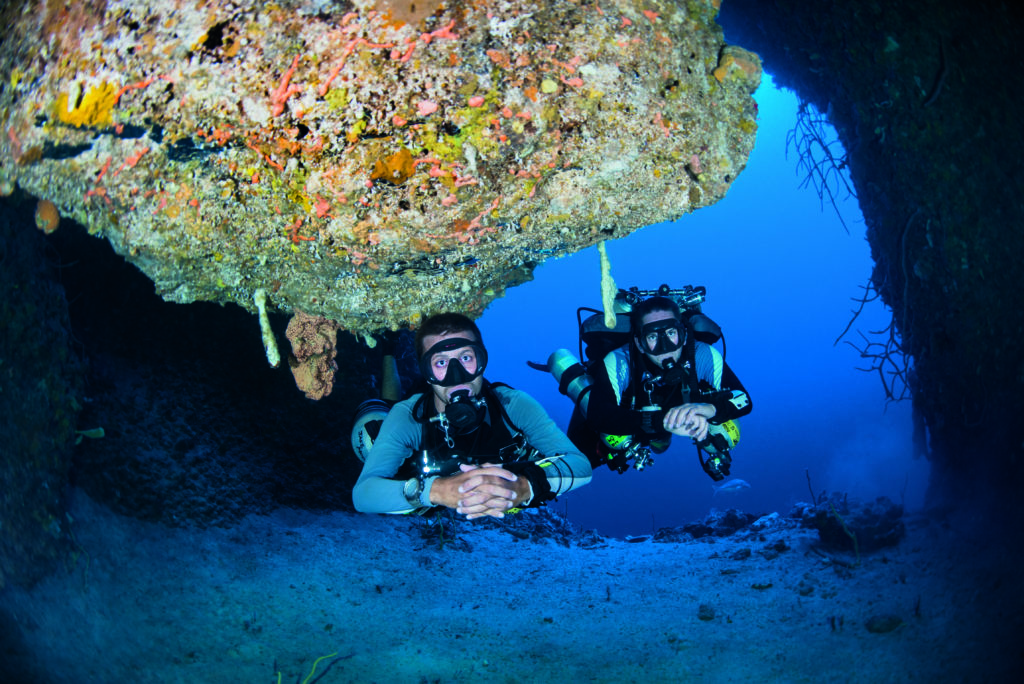STUART PHILPOTT dusts off his tech-diving skills in Utila, but admits that it felt strange to be heading off on a deep-ocean dive wearing just a rash-vest and board-shorts!
Utila has to be the backpacking / scuba-diver training hotspot of the Caribbean. With two resident British Course Directors at the time of my visit, Utila Dive Centre (UDC) seemed to be spearheading the campaign, attracting an eclectic mix of nationalities from European and Scandi right through to South American and Canadian.
Located as it is off the coast of Honduras, some way off the mass-tourism track, I didn’t expect to find a full-blown tech-diving centre complete with a range of “toys“ from twinsets, sidemounts and stage cylinders to closed-circuit rebreathers.

The experts
Dive manager Bel Chaves introduced me to Brit Scott Peaker and Canadian-born Jake Bulman, who were sharing UDC’s tech-diving workload between them. Scott offered to take me on a trimix dive, leaving Jake to focus on the rebreathers and, if I had time, the sidemounts.
For some time Scott had been running deep trimix courses around twice a month and sidemount courses three or four times a month. He usually conducts scuba-diver training dives at sites on the north side of Utila, with CJ’s Drop Off a particular favourite. “When you arrive at the dive-site, the wall is right there and goes all the way down past 90m,” he told me.
Scott shared space on the dive-boat used by recreational scuba divers, because this was the ideal pitching ground for tech courses. PADI Course Director Susie Phipps told me that UDC ran instructor courses every month and qualified more than 100 new instructors every year.
“It’s the perfect selling machine,“ was how she put it. “It’s easy to add on sidemount and rebreather courses after the IE has finished”. Everybody watches the tech divers going through briefings, kitting-up and disappearing into the deep blue, where they can’t follow, and this naturally generates curiosity and interest. “We have a constant flow of work”.
The tech centre has five sets of doubles and three sidemount rigs as well as deco cylinders and regs for hire.
Scott started diving in Fiji while working on a reef-conservation project. In two years he progressed to Divemaster level before moving to Utila and completing his tech training. Having logged more than 200 tech dives, he told me: “I love being able to explore and see places that only a few people are able to go. Tech opens up a whole different side of diving, from thoroughly planning dives from start to finish to all the different gear you can use and different gas mixes.
“It also allows you to build a strong team of friends among the people you dive with”.
Our objective was to find and enter a small cave at a maximum depth of 60m. “No one ever sees the cave because it’s so deep,” said Scott. Gas mix for the dive was a 20/20, with deco gases 50% and 100% 02. Total dive-time would be 60 minutes.
Scott and Jake didn’t know me from Adam, so were concerned about my safety. Admittedly, I hadn’t been tech diving for a few months and felt a bit rusty, so was happy to follow their guidelines. Scott gave a briefing so thorough that it felt like a simulated dry run of the entire dive! I could see that he was extremely conscientious, and am certain that he went through the same procedure with everyone he guided or trained.
We all turned up in multi-coloured board-shorts and rash-vests. There wasn’t one piece of black gear to be seen. Scott was concerned that this would somehow make the dive seem “less technical“ to the outside world, but the water temperature was hovering around the 30°C mark and would drop by no more than a degree or two at our target depth, so in my mind there was no problem. We were dressed suitably for the occasion – totally awesome, dude!

CJ’s Drop Off
The boat ride to CJ’s Drop Off takes about 45 minutes, which allowed me time to survey the coastline. For a small island (Utila covers an area of only 45sq km) there was a good variety of bars, restaurants and beaches to sample. Bel had her nose to the ground and knew exactly which establishments were offering a happy hour or a two-for-one on food, which helped me save a few extra dollars.
Under water, my trim needed some tweaking. I felt slightly inverted, and when laden down with stage cylinders this made finning harder than necessary. Tech gear should be comfortable, but I’m always being thrown in at the deep end (literally) using unfamiliar kit configurations. There never seems to be enough time for fine-tuning.
Wishing us bon voyage, a small hawksbill turtle did a fly-by. If it occurred to me momentarily to follow it for a photo, I quickly remembered that this was a serious tech dive with a planned run-time, and thought better of it. Keep focused on the dive and stick to the plan.
I followed behind Scott and Jake as we made our descent on the near-vertical wall. With visibility topping 30m, it was very dramatic looking back up at the surface. “I always get my students to look up because the wall actually overhangs slightly and towers over the top of you, making you feel tiny down there,” Scott had told me.
We passed a clump of orange tube sponges protruding from the wall. I kept the pace until we reached the cave entrance at our prescribed maximum depth. My Shearwater computer was recording bang on 60m. This turned out to be my best picture opportunity, with me inside the shallow cave looking back out into the blue, and Scott and Jake in the foreground.
A huge rock formation in the middle of the opening added some perspective, and it was adorned with colourful sponges to make the shot more interesting.
After a short period we turned around and ascended back up and around the wall. I stopped at the tube sponges to take another stream of pictures, then carried on up, completing deco stops along the way.
Back on the surface, everybody was happy. The dive couldn’t have gone any more smoothly from run-time to gas-management. No matter what the sea temperature, I don’t usually dive in anything less than a 5mm suit, especially on tech dives, but on this occasion the board-shorts had looked pretty cool (even with my chubby legs) and didn’t feel too cool!
Rebreather time
When I turned up next morning, Jake had already prepared the rebreathers for our day’s diving, so I didn’t have to spend any time assembling the unit, which made me feel very lazy and inadequate.
I had qualified as a TDI Poseidon rebreather diver a number of years ago while diving at the Dive-In Larnaca tech centre in Cyprus. Unfortunately, it was the same story as on the previous trimix dive – I was rusty with the workings of a Poseidon Se7en, so Jake went through all the procedures thoroughly before we entered the water.
Jake had learnt to dive in 2014. His first dive had been at West Hawk Lake, Canada, in 4°C water while wearing a holey wetsuit that was a complete contrast to board-short diving in the Caribbean.
He had completed his first rebreather dive in February 2015 and became an instructor that April. He had now got almost 100 hours on the Poseidon, and about 60 on his personal KISS Sidekick unit to total more than 180 logged tech dives. To date he had run 18 CCR courses at UDC.
We managed to jump aboard a boat heading out to a popular site called Duppy Waters. I noticed that all the boats had dedicated tech areas for storing twinsets and other gear, which was a nice touch.
I had about 70 hours’ experience on all types of rebreather from Inspiration and Megaladon to JJ and Liberty (courtesy of Rubicon in Lanzarote). But I don’t own one, so I can go several months, sometimes longer, without using a unit. Jake guided me through the pre-breathe cycle and standard Se7en start-up procedure, which was basically “follow the instructions on the handset“.
The mooring-line sat next to the drop-off at a depth of about 8m-9m, so I hovered close to the seabed and spent the first few minutes just getting used to buoyancy again.
Using standard scuba it’s easy to breathe in and out and instantaneously ascend / descend a metre or two. This works well with photography, because I am constantly changing position and depth while trying to get the best composition. But when I’m using a rebreather, breathing in and out doesn’t adjust buoyancy.
This calls for a different approach, and takes a while to get used to. I practised taking a few pictures of Jake beneath the boat before we descended along the wall to around 30m. Jake guided me to a number of overhangs and narrow swim-throughs, which tested my recently honed buoyancy skills. I must admit that there were a few extra dents and scratches on the rebreather after my dive!
We finned along the outer edges of the reef, admiring the scenery. A solitary barracuda came in for a closer look. I stopped to take some pictures of a large green moray and an inquisitive pufferfish. The lack of noisy exhaled bubbles made the atmosphere seem far more serene.
“Rebreathers are so silent, it makes swimming through a cave or floating around in the ocean a whole different experience,” observed jake. “You can hear your heartbeat sometimes”.
Back at the surface
Embarrassingly, I forgot to exhale on the ascent. The gas in the loop expands, thus increasing buoyancy, and exhaling through your nose easily remedies the problem – as long as you remember! I got there in the end, but felt uneasy for a few moments. How many hours did I have on rebreathers? I felt such an idiot.
Jake was totally hooked on rebreathers. “They are more hydrodynamic than twinsets, so you can move quicker and warmer due to the moist gas and with less deco, all while using less gas. What more could you want?”
UDC had cornered Utila’s tech-diving market, with the rebreather and sidemount courses leading in the popularity stakes. The tech trimix courses require a longer time commitment, which might be a turn-off for some. Scott said that it would take at least six days to qualify.
Tech diving in tropical conditions does have its attractions. Utila offers a good range of dive-sites down to 90m and beyond, there was very little current to contend with and visibility usually exceeded 30m – not forgetting that I could comfortably wear my super-duper board-shorts.
Jake’s favourite tech site, Pumping Hill Banks, offered the bonus attraction of lionfish-hunting. But do lionfish, tech diving and board shorts really mix? My imagination was running riot – it would take only one sneaky lionfish up the shorts and whoa! Just think of that pain and swelling, all while completing 30 minutes of deco stops!
UTILA DIVE CENTRE
Utila Dive Centre was established back in 1991, and has since steadily grown in terms of facilities and reputation. A PADI CDC – among many other titles! – it offers all levels of training right up to various instructor ratings, as well as boasting a comprehensive technical-diving set-up with twinsets, sidemount kit and closed-circuit rebreathers. Whether you‘re new to tech diving and want to get certified, are qualified and just want to head out on “fun” tech dives, or are ready to step up and obtain your tech instructor ratings, UDC can help you out.
Photographs by Stuart Philpott
Also on Divernet: Similan Islands: Diving The Sea Of A Million Stars, Diving Deeper On Royal Adelaide, Why Dorset Dive Kyarra Is A National Treasure





